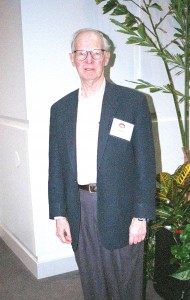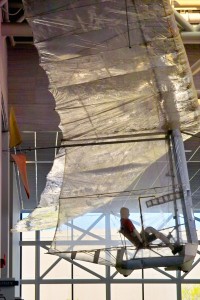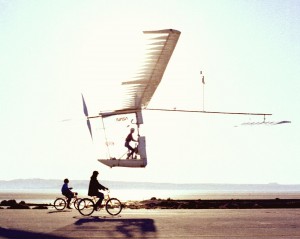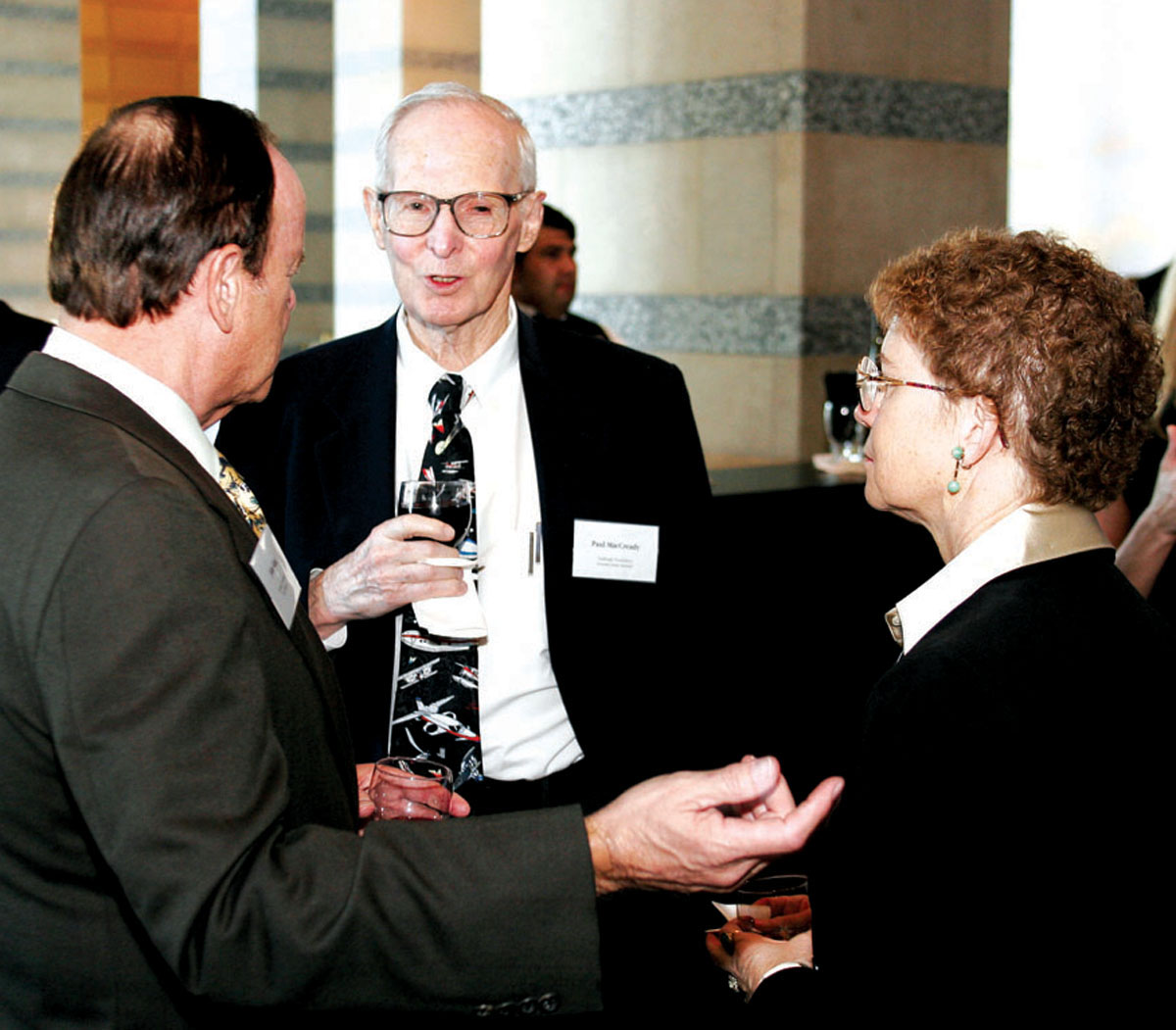
Dr. Paul MacCready (center), shown with John and Martha King of the King Schools during the 2006 Lindbergh Awards, was a 1982 Lindbergh Award winner. The chairman of AeroVironment, Inc. strongly advocated the mission of the Lindbergh Foundation.
By Clayton Moore
Pilots, scientists and appreciative admirers of scientific and human achievement bowed their heads in September to mark the passing of one of their own. Dr. Paul B. MacCready Jr., a visionary engineer dubbed “one of the greatest minds of the 20th century,” by TIME Magazine, succumbed to brain cancer on Aug. 28, 2007.
In his 81 years of life and work, the man known by many in the aviation industry as “the father of human-powered flight” transformed the field of solar-powered locomotion as well as glider flight. His bold experimentation and imaginative approach ultimately brought him great success, despite his resolutely untraditional approach.
“Any big idea I’ve ever had has always come to me in daydreams,” MacCready said of his unusual outlook on the aviation world.
An experimental mind
Paul Beattie MacCready was born in New Haven, Conn. on Sept. 25, 1925, to a family of doctors. He showed a flair for invention from an early age, building model planes to fuel his creativity.
“Looking back, I realize it was a good substitute for always being the smallest kid in the class,” MacCready said. “Anyone who’s not interested in model airplanes must have a screw loose somewhere. Ornithopters, autogyros, helicopters, indoor models, outdoor models. Nobody seemed to be quite as motivated for the new and strange as I was.”

Dr. Paul B. MacCready, 1956 World Soaring Champion, described how to “do more with less” and achieve Albatross-like flight during his lecture at the 2005 Soaring Society of America Convention & Air Expo.
The creative young man soon graduated to real flying, winning a national contest by building a model flying machine at age 15 and earning his pilot’s license by the age of 16. He trained as a U.S. Navy pilot near the end of World War II, although he never flew in combat.
He graduated from Hopkins School in 1943. His educational progression was rapid following the war, despite the fact that MacCready struggled with mild dyslexia. He earned his bachelor’s degree in physics from Yale University in 1947, and received a master’s and a PhD from the California Institute of Technology by 1952.
With his schooling behind, he founded Meteorology Research, Inc., a company that pioneered concepts in weather modification, including the controversial practice of cloud seeding. MacCready also pioneered the use of small, instrumented aircraft to study deadly storms, often piloting the more taxing missions personally.
During this time, MacCready started gliding and showed a true flair for the sport. He was a three-time winner of the Richard C. Du Pont Memorial Trophy, awarded to the U.S. National Open Class Soaring Champion, and in 1956, he became the first American pilot to become the World Gliding Champion.
Among the engineer’s lasting scientific achievements is the MacCready “speed to fly” theory, which determines the correct speed to fly a glider by calculating the air conditions and the glider’s rate of sink at different air speeds. Glider pilots still use a device called the MacCready “speed ring” to help them determine the correct speed to fly.
MacCready founded a new company, AeroVironment, Inc., in 1971 with the challenge of “doing more with less,” a philosophy that drove the company to new heights and inspired dozens of eclectic aircraft, starting with one of its founder’s most remarkable designs.
A bad debt inspired the scientist’s most famous achievement. After guaranteeing a loan for a relative’s failed business, the scientist found himself stuck with a $100,000 debt. While brainstorming a solution to his quandary, he recalled a contest organized by British industrialist Henry Kremer to reward the creator of a machine capable of human-powered flight.

In 2005, Paul MacCready (left) reunited with two members of the Gossamer Condor team during an event sponsored by the American Geographical Society. They included “pilot-engine” Bryan Allen (center) and co-inventor Peter Lissaman.
“The Kremer Prize, in which I’d had no interest, was just about equal to my debt,” MacCready said. “Suddenly, human-powered flight seemed important.”
The daydreamer took inspiration from watching hawks and vultures fly over California, calculating their flight speed and turning radius just as he would in his own gliders. He determined that as a wing became larger, it required less power to keep it in the air. If he could triple the wingspan of a glider, a trim athlete could keep it aloft.
After numerous versions crashed in the testing process, he entered the sole survivor, the Gossamer Condor. His sense of humor intact, the engineer conceded that this perhaps was “not the way to develop airliners.”
At only 70 pounds, the Gossamer Condor was built from piano wire, bicycle parts and translucent plastic film. It was an odd-looking bird, but up to the task, though its pilot said it was “like pedaling a house.” On Aug. 23, 1977, bicycle racer Bryan Allen, acting as “pilot-engine,” successfully flew the glider through a seven-mile course in California, earning MacCready the $95,000 prize. A documentary film of the project, “The Flight of the Gossamer Condor,” won an Academy Award in 1978.

Paul MacCready’s most famous design, the Gossamer Condor, hangs in the Smithsonian’s Air and Space Museum alongside the Wright brothers’ glider.
Two years later, MacCready took Kremer’s challenge to launch an improved version, now called the Gossamer Albatross, across the English Channel. Allen again piloted the aircraft, making the 22-mile journey in less than three hours. MacCready’s team took home a prize of $213,000, the largest cash prize in aviation history at the time.
Today, the Gossamer Condor remains on permanent display at the National Air and Space Museum in Washington, D.C. and the Gossamer Albatross is displayed in the museum’s Udvar-Hazy Center near Washington Dulles International Airport (IAD). The Smithsonian also retains several other MacCready-designed vehicles, including both aircraft and electric vehicles, in its permanent collection.
A sustainable vision for the future
MacCready had become fascinated by solar power, though he admitted that, “as a commercial proposition, solar flight is wildly impractical.” Never one to let logic stand in the way of progress, MacCready designed the Gossamer Penguin, the first flight powered only by the sun, and a refined version, the Solar Challenger, which flew 163 miles from Paris to Canterbury at 11,000 feet in 1981.
His interest in solar power was both imaginative and prescient. As early as 1981, MacCready warned of the consequences of dependency on a single nonrenewable fuel source.
“I really believe that half the populace would be willing to send my sons to the Middle East to fight a war to protect the supply of oil to keep their cars going,” he said at the time. “I keep asking what I can do to improve our approach to energy.”
Inspired by his strong sense of environmental responsibility, MacCready collaborated with General Motors on the design of the Sunraycer, a solar-powered car that in 1987 won a 1,800 mile race between Darwin and Adelaide, Australia. His Impact concept car provided the basis for General Motor’s first production model of an electric-powered car, the EV-1. The vehicle won a loyal following and was lauded by environmentalists, despite losing $1 billion for General Motors.

Human power was behind many of Paul MacCready’s most visionary designs including the Gossamer Albatross II, seen here during a NASA test flight.
“The overall goal is a sustainable world,” MacCready said. “Not consuming nonreplenishable resources, not getting steadily more dependent on foreign oil and not causing global climate change.”
Sometimes his unpractical applications provided the most audacious results. In 1985, the engineer was commissioned to build a life-size, remote-controlled replica of a pterodactyl for the Smithsonian Institute. MacCready responded with gusto, flying the odd glider over Death Valley, Calif. His resurrected dinosaur appears in the Smithsonian’s IMAX film, “On the Wing.”
His rare failures included one misguided attempt to power a small plane using a hamster.
“Hamsters are lazy,” he said. “A rat may do the trick.”
For the past decade, one of MacCready’s areas of interest was in building small, toy-like aircraft outfitted with cameras to transmit images, first for the Department of Defense and later in conjunction with NASA. AeroVironment sells it vehicles, such as the 9-pound Pointer, to the U.S. military in significant quantities for use in surveillance and counterintelligence.
“You’re looking out as if you were a little creature inside,” he said. “You can soar with the birds. It’s as if you’re one of them. If I hadn’t been doing the ornithopters 60 years ago, there wouldn’t have been a Gossamer Condor or Albatross, or an Impact or a mandate in California on zero-emission vehicles. It’s a toy, but it’s a pretty important toy.”

The solar-powered Helios aircraft, designed in cooperation with NASA, achieved a record-breaking altitude higher than the SR-71 Blackbird. Paul MacCready theorized that the glider could fly on Mars because of its efficient design.
His affection for the fields of solar power and glider flight never dimmed. In 2001, he completed work on an unmanned solar aircraft with a wingspan of 247 feet dubbed Helios. It flew higher than the SR-71 Blackbird, reaching an altitude of 97,000 feet and setting a world record for a non-rocket powered plane.
“Soaring has shown the way to become more efficient in many ways, and is also just plain fun,” MacCready often said during a lecture entitled “The Present and Future of Elegant Soaring.”
Dr. MacCready was the recipient of hundreds of awards, including the Engineer of the Century award given by the American Society of Mechanical Engineers, seven honorary degrees, Aviation Week’s Aerospace Laureate designation, and Graduate of the Decade by the California Institute of Technology. The aviation community formally recognized MacCready when he was enshrined in the National Aviation Hall of Fame in 1991.
Another honor he treasured came in 1982 when MacCready received the Lindbergh Award from The Charles A. and Anne Morrow Lindbergh Foundation. He later served on the organization’s board of directors. He often cited the recognition as a turning point in his life during which he began to examine more carefully the balance between nature and technology.
“I’m more interested in a world that works than what sells,” he said.











